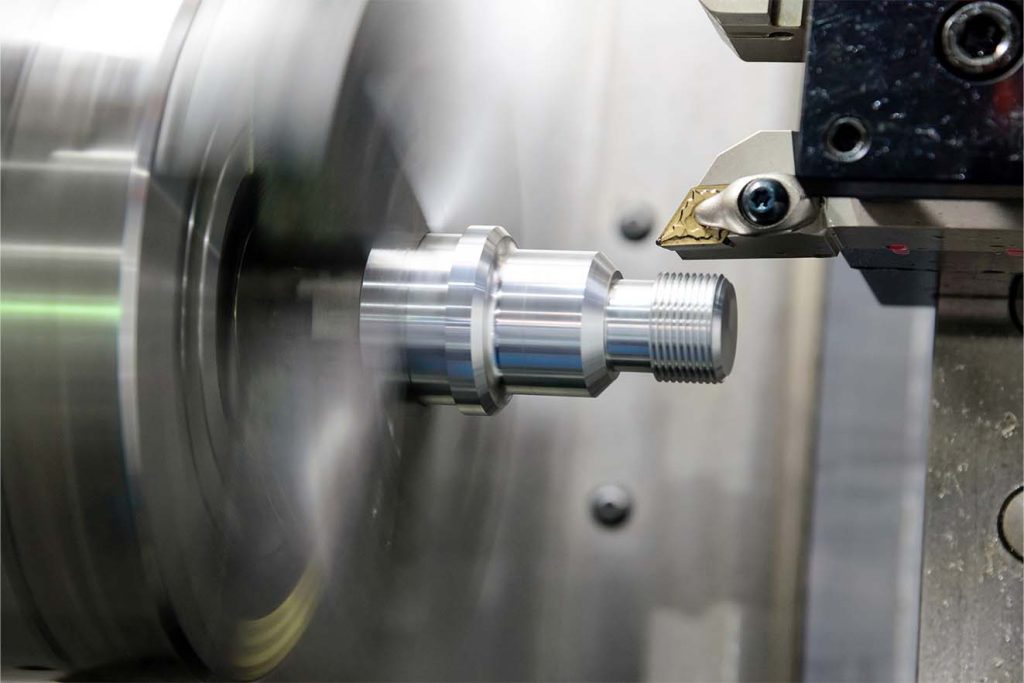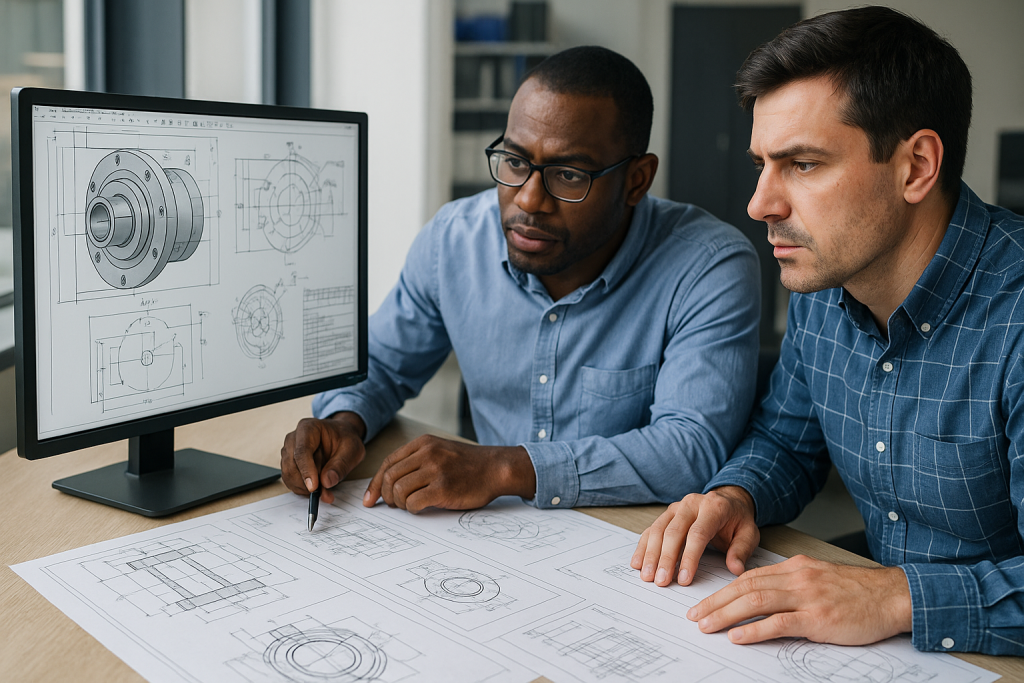
CNC Turning is a cornerstone of modern manufacturing, enabling the creation of highly accurate cylindrical components across industries. Whether it’s for automotive shafts, aerospace bushings, or custom medical parts, CNC turning delivers unmatched precision and repeatability. But how exactly does this process achieve such impressive results?
In this article, we’ll break down the mechanisms of CNC turning, highlight its precision advantages, and integrate insights from Boona Prototypes — a leading China-based CNC manufacturer with expertise in custom lathe services and small batch CNC machining.
I. What Is CNC Turning?
CNC Turning is a subtractive manufacturing process that involves rotating a workpiece while a cutting tool removes material to shape the desired geometry. Typically performed on a CNC lathe, this method is ideal for producing symmetrical, round, or cylindrical components with tight tolerances.
Key components include:
- Lathe Spindle: Rotates the workpiece.
- Tool Turret: Holds and switches between multiple cutting tools.
- CNC Controller: Guides the machine based on programmed G-code instructions.
📌 Learn more about the process on Boona’s CNC Turning page.
II. CNC Turning Workflow: From CAD to Finished Part
| Step | Description |
|---|---|
| CAD Modeling | Engineers create 2D or 3D designs using CAD tools like SolidWorks or AutoCAD. |
| CAM Programming | CAD files are converted into G-code using CAM software. |
| Machine Setup | Workpiece is mounted, tools calibrated, and machining parameters configured. |
| Machining | CNC system executes the program, shaping the part via G-code based CNC lathe operations. |
Each step ensures the final part matches the original design within micrometer-level tolerances, enabling tight tolerance turning.
III. What Makes CNC Turning So Precise?
1. Computer-Guided Motion Control
The use of servo motors and ball screw mechanisms ensures tool movements are precise to within ±0.01 mm. The CNC controller translates G-code into movement commands, maintaining accuracy throughout the machining cycle.
2. Multi-Axis Tool Paths
Standard 2-axis turning involves X (diameter) and Z (length) movements, while advanced setups include Y and C axes for complex geometries. These multi-axis CNC turning operations enable higher complexity and automation.
3. Closed-Loop Feedback Systems
Encoders and sensors provide real-time data to correct positional errors, ensuring consistent quality even during long production runs. These systems are key in automated turning solutions.
IV. Key CNC Turning Operations
| Operation | Function |
| Facing | Smooths and flattens the end of a cylindrical blank. |
| Straight Turning | Reduces diameter uniformly along the Z-axis. |
| Taper Turning | Creates angled surfaces (e.g., cones). |
| Boring | Enlarges internal diameters with precise accuracy. |
| Threading | Cuts internal or external threads using synchronized motion. |
| Parting/Grooving | Separates or channels the workpiece for assembly. |
These processes are part of custom CNC lathe work that ensures complex shapes are produced with repeatability.
V. Technical Capabilities from Boona Prototypes
Boona Prototypes offers precision CNC turning tailored for various applications. Below is a sample of their machining capabilities:
| Parameter | Specification |
| Max Turning Diameter | Up to Ø 300 mm |
| Max Turning Length | Up to 600 mm |
| Tolerance Range | ±0.01 mm or better (depending on material/geometry) |
| Surface Finish Options | Ra 1.6–3.2 μm (standard), < 0.8 μm (fine finishes) |
| Materials Supported | Aluminum, Steel, Brass, Titanium, Plastics, Alloys |
| Batch Size | Prototype (1 pcs) to Large Volume (>10,000 pcs) |
🔧 Explore full CNC capabilities at Boona Prototypes.
VI. Advanced Technology for Superior Precision
Boona’s turning centers are equipped with:
- Live Tooling CNC Lathes
- Bar Feeders & Auto Loaders
- Tool Presetters & Probes
- ISO Certified CNC Machining Shop Standards
- Post-Machining Processes: including anodizing, polishing, and surface treatments for aluminum CNC turning services
These systems support prototype to production CNC services with superior efficiency.
🌐 Visit the Boona Prototypes homepage for complete information on CNC milling, CNC prototyping, and custom machining solutions.
VII. Applications of CNC Turning
CNC turned parts are used in:
- Aerospace: turbine shafts, hydraulic bushings
- Automotive: gear shafts, engine sleeves
- Medical: surgical components, orthopedic implants
- Robotics & Electronics: sensor housings, threaded connectors
If you’re looking for CNC shaft turning service, Boona Prototypes offers a complete solution from start to finish.
VIII. Final Thoughts
CNC Turning isn’t just about removing material—it’s about creating dimensionally perfect parts with consistent quality. By combining precision turned parts, advanced machining equipment, and expert-level engineering, manufacturers like Boona Prototypes deliver world-class results.
Need a rapid CNC prototyping solution or online CNC turning quote? Contact Boona today and experience why they are one of the top CNC machining suppliers in Asia.
FAQs
1. What is CNC turning and how does it differ from CNC milling?
CNC turning is a subtractive manufacturing process where a rotating workpiece is shaped by a stationary cutting tool, typically using a CNC lathe. It’s ideal for producing cylindrical and symmetrical parts. In contrast, CNC milling uses a rotating tool to remove material from a stationary workpiece, making it more suitable for complex, non-round geometries.
2. What tolerances can be achieved with CNC turning?
Precision CNC turning can routinely achieve tolerances as tight as ±0.01 mm, depending on the material and geometry. At Boona Prototypes, tighter tolerances can be accommodated upon request, particularly for aerospace and medical-grade parts.
3. Which materials are suitable for CNC turning?
Common materials used in CNC turning include:
-
Metals: Aluminum, Stainless Steel, Brass, Titanium, Copper
-
Plastics: PEEK, PTFE, Nylon, ABS, Delrin
Boona Prototypes supports a wide variety of materials for custom CNC lathe work.
4. What is the maximum part size Boona Prototypes can turn?
Boona Prototypes can handle turning diameters up to Ø 300 mm and lengths up to 600 mm, making them ideal for both small components and larger industrial parts.
5. How is precision ensured during CNC turning?
Precision is maintained through:
-
Servo motor-controlled axes
-
G-code based automation
-
Real-time closed-loop feedback systems
-
High-accuracy tool calibration
These systems enable tight tolerance turning and excellent repeatability in automated turning solutions.
6. Can I request CNC prototypes before mass production?
Yes! Boona Prototypes specializes in rapid CNC prototyping and small batch CNC turning, allowing clients to test fit, form, and function before scaling up.
7. What are the lead times for CNC turning services?
Standard turnaround times vary from 3–7 working days depending on part complexity and quantity. Urgent jobs can be expedited. Request an online quote here.
8. Are surface finishing options available for turned parts?
Absolutely. Boona offers a range of surface finishes including:
-
Anodizing (for aluminum)
-
Polishing
-
Bead blasting
-
Electroplating
These finishes enhance both aesthetics and corrosion resistance.
9. Do CNC turned parts require secondary machining?
Sometimes. While most precision turned parts can be finished in one setup, complex features (e.g., slots, cross-holes) may require live tooling or follow-up CNC milling, both of which are supported by Boona.
10. Can Boona Prototypes handle international orders?
Yes. Boona Prototypes is a China-based CNC manufacturer that ships globally. Their team supports clients in North America, Europe, Southeast Asia, and beyond.



